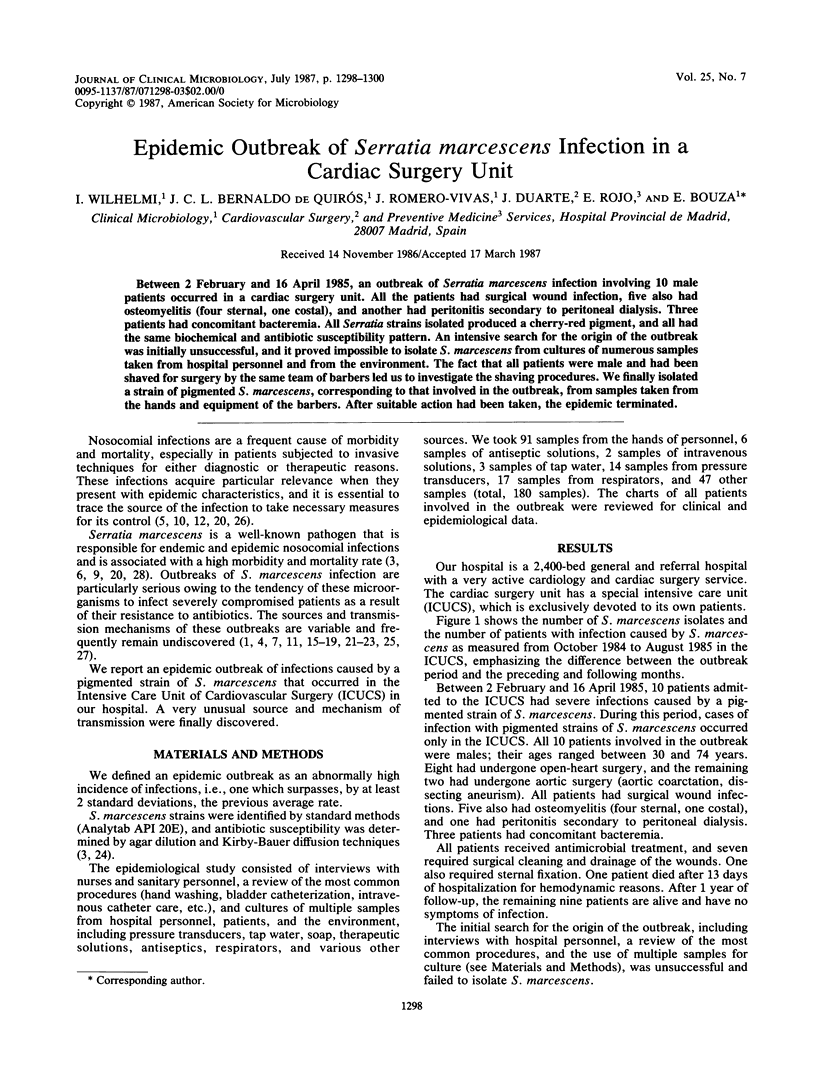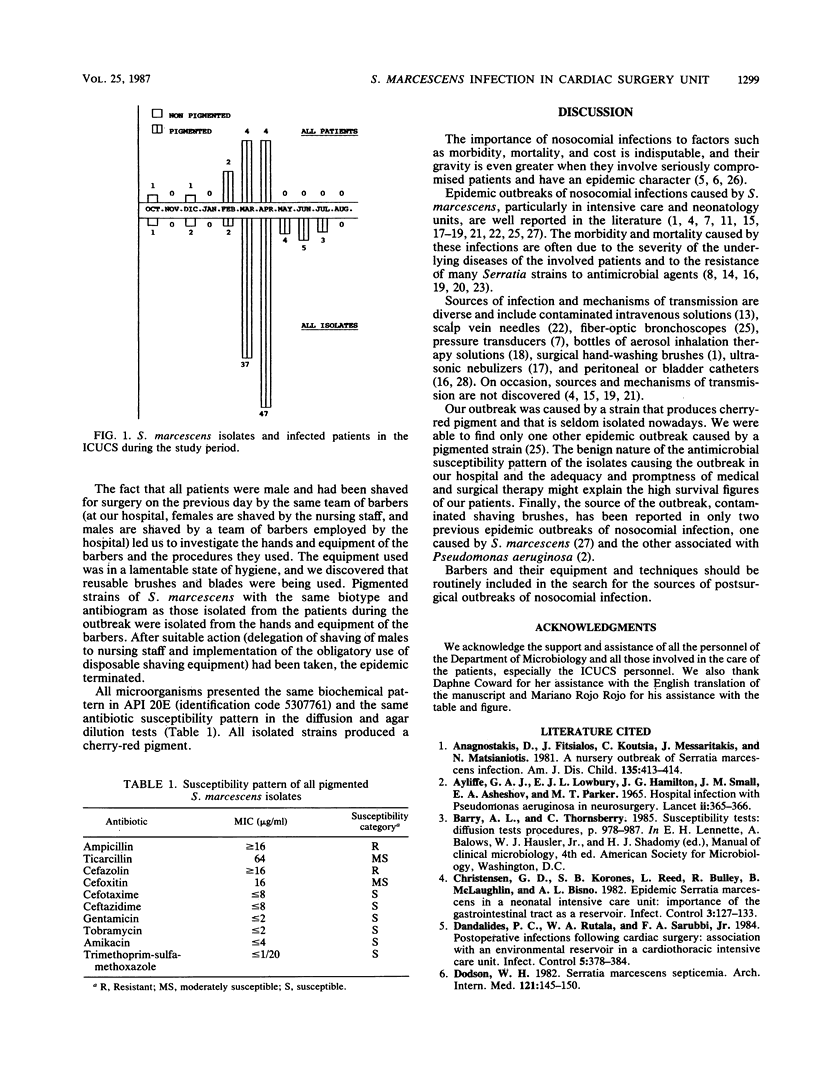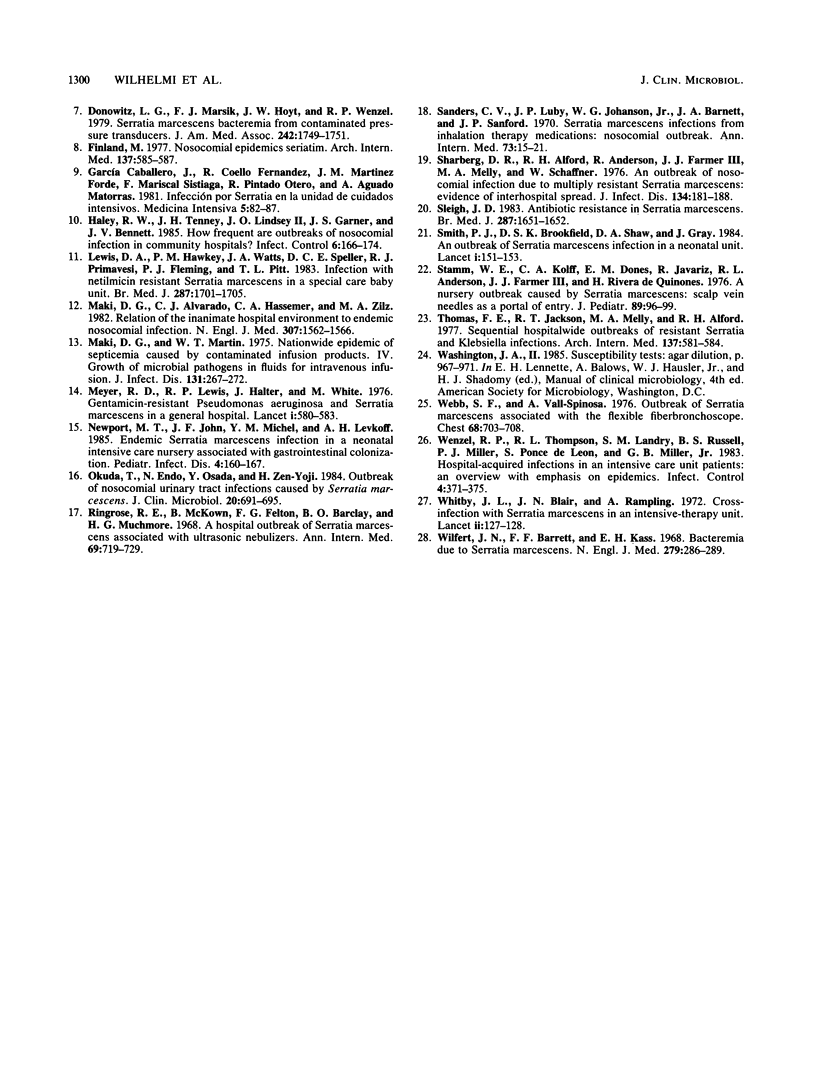Abstract
Between 2 February and 16 April 1985, an outbreak of Serratia marcescens infection involving 10 male patients occurred in a cardiac surgery unit. All the patients had surgical wound infection, five also had osteomyelitis (four sternal, one costal), and another had peritonitis secondary to peritoneal dialysis. Three patients had concomitant bacteremia. All Serratia strains isolated produced a cherry-red pigment, and all had the same biochemical and antibiotic susceptibility pattern. An intensive search for the origin of the outbreak was initially unsuccessful, and it proved impossible to isolate S. marcescens from cultures of numerous samples taken from hospital personnel and from the environment. The fact that all patients were male and had been shaved for surgery by the same team of barbers led us to investigate the shaving procedures. We finally isolated a strain of pigmented S. marcescens, corresponding to that involved in the outbreak, from samples taken from the hands and equipment of the barbers. After suitable action had been taken, the epidemic terminated.
Full text
PDF


Selected References
These references are in PubMed. This may not be the complete list of references from this article.
- AYLIFFE G. A., LOWBURY E. J., HAMILTON J. G., SMALL J. M., ASHESHOV E. A., PARKER M. T. HOSPITAL INFECTION WITH PSEUDOMONAS AERUGINOSA IN NEUROSURGERY. Lancet. 1965 Aug 21;2(7408):365–368. doi: 10.1016/s0140-6736(65)90343-0. [DOI] [PubMed] [Google Scholar]
- Anagnostakis D., Fitsialos J., Koutsia C., Messaritakis J., Matsaniotis N. A nursery outbreak of Serratia marcescens infection. Evidence of a single source of contamination. Am J Dis Child. 1981 May;135(5):413–414. doi: 10.1001/archpedi.1981.02130290011005. [DOI] [PubMed] [Google Scholar]
- Christensen G. D., Korones S. B., Reed L., Bulley R., McLaughlin B., Bisno A. L. Epidemic Serratia marcescens in a neonatal intensive care unit: importance of the gastrointestinal tract as a reservoir. Infect Control. 1982 Mar-Apr;3(2):127–133. doi: 10.1017/s0195941700055909. [DOI] [PubMed] [Google Scholar]
- Dandalides P. C., Rutala W. A., Sarubbi F. A., Jr Postoperative infections following cardiac surgery: association with an environmental reservoir in a cardiothoracic intensive care unit. Infect Control. 1984 Aug;5(8):378–384. doi: 10.1017/s0195941700062214. [DOI] [PubMed] [Google Scholar]
- Dodson W. H. Serratia marcescens septicemia. Arch Intern Med. 1968 Feb;121(2):145–150. [PubMed] [Google Scholar]
- Donowitz L. G., Marsik F. J., Hoyt J. W., Wenzel R. P. Serratia marcescens bacteremia from contaminated pressure transducers. JAMA. 1979 Oct 19;242(16):1749–1751. [PubMed] [Google Scholar]
- Finland M. Nosocomial epidemics seriatim. Multidrug-resistant bacteria and R factors. Arch Intern Med. 1977 May;137(5):585–587. doi: 10.1001/archinte.137.5.585. [DOI] [PubMed] [Google Scholar]
- Lewis D. A., Hawkey P. M., WattsJA, Speller D. C., Primavesi R. J., Fleming P. J., Pitt T. L. Infection with netilmicin resistant Serratia marcescens in a special care baby unit. Br Med J (Clin Res Ed) 1983 Dec 3;287(6406):1701–1705. doi: 10.1136/bmj.287.6406.1701. [DOI] [PMC free article] [PubMed] [Google Scholar]
- Maki D. G., Alvarado C. J., Hassemer C. A., Zilz M. A. Relation of the inanimate hospital environment to endemic nosocomial infection. N Engl J Med. 1982 Dec 16;307(25):1562–1566. doi: 10.1056/NEJM198212163072507. [DOI] [PubMed] [Google Scholar]
- Maki D. G., Martin W. T. Nationwide epidemic of septicemia caused by contaminated infusion products. IV. Growth of microbial pathogens in fluids for intravenous infusions. J Infect Dis. 1975 Mar;131(3):267–272. doi: 10.1093/infdis/131.3.267. [DOI] [PubMed] [Google Scholar]
- Meyer R. D., Lewis R. P., Halter J., White M. Gentamicin-resistant Pseudomonas aeruginosa and Serratia marcescens in a general hospital. Lancet. 1976 Mar 13;1(7959):580–583. doi: 10.1016/s0140-6736(76)90370-6. [DOI] [PubMed] [Google Scholar]
- Newport M. T., John J. F., Michel Y. M., Levkoff A. H. Endemic Serratia marcescens infection in a neonatal intensive care nursery associated with gastrointestinal colonization. Pediatr Infect Dis. 1985 Mar-Apr;4(2):160–167. doi: 10.1097/00006454-198503000-00010. [DOI] [PubMed] [Google Scholar]
- Okuda T., Endo N., Osada Y., Zen-Yoji H. Outbreak of nosocomial urinary tract infections caused by Serratia marcescens. J Clin Microbiol. 1984 Oct;20(4):691–695. doi: 10.1128/jcm.20.4.691-695.1984. [DOI] [PMC free article] [PubMed] [Google Scholar]
- Ringrose R. E., McKown B., Felton F. G., Barclay B. O., Muchmore H. G., Rhoades E. R. A hospital outbreak of Serratia marcescens associated with ultrasonic nebulizers. Ann Intern Med. 1968 Oct;69(4):719–729. doi: 10.7326/0003-4819-69-4-719. [DOI] [PubMed] [Google Scholar]
- Sanders C. V., Jr, Luby J. P., Johanson W. G., Jr, Barnett J. A., Sanford J. P. Serratia marcescens infections from inhalation therapy medications: nosocomial outbreak. Ann Intern Med. 1970 Jul;73(1):15–21. doi: 10.7326/0003-4819-73-1-15. [DOI] [PubMed] [Google Scholar]
- Schaberg D. R., Alford R. H., Anderson R., Farmer J. J., 3rd, Melly M. A., Schaffner W. An outbreak of nosocomial infection due to multiply resistant Serratia marcescens: evidence of interhospital spread. J Infect Dis. 1976 Aug;134(2):181–188. doi: 10.1093/infdis/134.2.181. [DOI] [PubMed] [Google Scholar]
- Sleigh J. D. Antibiotic resistance in Serratia marcescens. Br Med J (Clin Res Ed) 1983 Dec 3;287(6406):1651–1653. doi: 10.1136/bmj.287.6406.1651. [DOI] [PMC free article] [PubMed] [Google Scholar]
- Smith P. J., Brookfield D. S., Shaw D. A., Gray J. An outbreak of Serratia marcescens infections in a neonatal unit. Lancet. 1984 Jan 21;1(8369):151–153. doi: 10.1016/s0140-6736(84)90074-6. [DOI] [PubMed] [Google Scholar]
- Stamm W. E., Kolff C. A., Dones E. M., Javariz R., Anderson R. L., Farmer J. J., 3rd, de Quinones H. R. A nursery outbreak caused by Serratia marcescens--scalp-vein needles as a portal of entry. J Pediatr. 1976 Jul;89(1):96–99. doi: 10.1016/s0022-3476(76)80940-7. [DOI] [PubMed] [Google Scholar]
- Thomas F. E., Jackson R. T., Melly A., Alford R. H. Sequential hospitalwide outbreaks of resistant Serratia and Klebsiella infections. Arch Intern Med. 1977 May;137(5):581–584. [PubMed] [Google Scholar]
- Wenzel R. P., Thompson R. L., Landry S. M., Russell B. S., Miller P. J., Ponce de Leon S., Miller G. B., Jr Hospital-acquired infections in intensive care unit patients: an overview with emphasis on epidemics. Infect Control. 1983 Sep-Oct;4(5):371–375. doi: 10.1017/s0195941700059774. [DOI] [PubMed] [Google Scholar]
- Whitby J. L., Blair J. N., Rampling A. Cross-infection with Serratia marcescens in an intensive-therapy unit. Lancet. 1972 Jul 15;2(7768):127–129. doi: 10.1016/s0140-6736(72)91612-1. [DOI] [PubMed] [Google Scholar]
- Wilfert J. N., Barrett F. F., Kass E. H. Bacteremia due to serratia marcescens. N Engl J Med. 1968 Aug 8;279(6):286–289. doi: 10.1056/NEJM196808082790604. [DOI] [PubMed] [Google Scholar]


